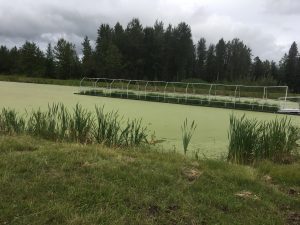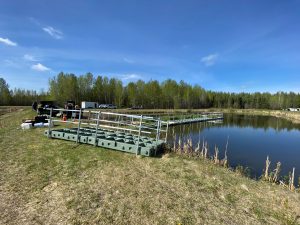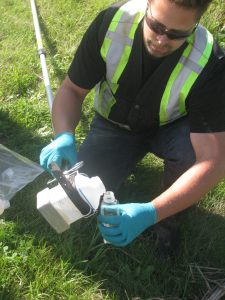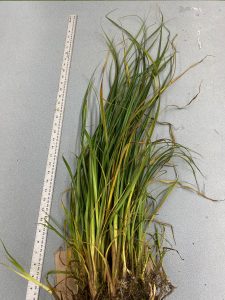Allyn Esau, Valerie Miller, Sarah Wilkinson, M Anne Naeth, University of Alberta
In a joint project between Brazeau County and the University of Alberta, Dr M Anne Naeth from the Faculty of Agricultural, Life and Environmental Sciences and Dr Mohamed Gamal El-Din from the Faculty of Engineering are working with their research teams to assess the effectiveness of constructed floating wetlands (CFWs) at the Violet Grove water treatment lagoon. The CFWs were built with Covey Associates Ltd in 2019. Constructed floating wetlands are floating platforms made from crates containing wetland plant species, which are expected to take up contaminants (excess nutrients and metals) in the water. CFWs are expected to provide a cost effective natural option for improving water quality at municipal treatment lagoons, and to be self-sustaining, resilient ecosystems.
CFWs have been used around the world, with a few in Canada. Scientific research to determine if they are effective over multiple years is rarely conducted, although it is important to ensure the water released to the environment is safe. We are specifically interested in whether CFWs can function in cold Canadian climates, as much more research has been done in warm climates.

The CFWs consist of floating wetland modules made of low density polyethylene, each containing 15 crates with 5 plants per crate. The plants grow in gravel and are suspended with their roots submerged in the treatment lagoon. Initially, 10 CFWs were installed, with half of the modules planted with water sedge (Carex aquatilis) and the other half with panicled bulrush (Scirpus microcarpus). Each of these is native to Alberta and can be locally sourced. In May 2021, the treatment area was doubled, so there are 20 floating wetland modules with 1,500 individual plants. An additional CFW was added this spring with five native wetland species: American manna grass (Glyceria grandis), American slough grass (Beckmannia syzigachne), turned sedge (Carex retrorsa), soft bulrush (Schoenoplectus tabernaemontani) and Baltic rush (Juncus balticus). We will determine which of these species are best suited to remove contaminants.

An aeration system was installed this spring to add oxygen below some of the CFWs. Changes in the water and plant rooting zone due to aeration are expected to improve plant growth and therefore increase removal of contaminants from the water.
To determine whether CFWs improve water treatment, we collect plant samples from the CFWs and water samples from the lagoon. Plant samples are washed to remove debris or wastewater that may be on the surface of shoots or roots, allowing us to determine what is in the plant tissue. The plants are oven dried and sent to a commercial laboratory to analyze nutrient and metal concentrations in tissue, which indicates how well they’re cleaning up the water. Analyzing shoots and roots separately helps to identify the part of the plant where most nutrients and metals are stored. We measure the maximum length and total dry biomass of shoots and roots. The tissue concentration and plant growth data together allow us to determine which species have the greatest potential to enhance wastewater treatment at the lagoon. Research results will allow Brazeau County to maintain and modify their CFWs as needed to ensure they are effective and efficient. This project can act as a model for other municipalities and counties, and data will be shared with the greater scientific community as well as the general public.
Plants are assessed throughout the growing season from May to October, to help us understand how plants uptake of nutrients and metals at different stages of their annual life cycle. All species have established and are in overall good health. American manna grass and soft bulrush have some of the tallest plants; American manna grass and panicled bulrush have the longest roots. Each fall, the plants are harvested and removed from the platform so that they do not decompose into the system, reintroducing contaminants that have been removed.
The lagoon with its constructed floating wetlands is developing into a natural ecosystem. We see white tailed deer browsing around the edge of the clearing near the lagoon. There are always song birds and ducks, even coyotes. In 2019, wetland plants were heavily browsed by muskrat. This year, there is less evidence of wildlife browsing, with half of the species affected. It is exciting to see seeds developing on the wetland plants, a sign of healthy plants and year after year success. This year, small numbers of other plant species have been found growing in the CFWs. These include horsetail (Equisetum spp.), fireweed (Epilobium angustifolium) and brome grass (Bromus spp.), and duckweed (Lemna minor) has naturally established on the lagoon surface.




Working on this project presented an interesting opportunity to tie into the work of the Land Reclamation International Graduate School (LRIGS) at the University of Alberta. LRIGS works to connect its membership of land reclamation students with scientists, industry and regulatory personnel. It provides opportunities for students and the public to learn about active reclamation projects, their diversity, and how the knowledge and skills LRIGS students are gaining can be applied to the world. LRIGS facilitates the transfer of land reclamation research results to industry, regulatory agencies, stakeholders, the public and the greater scientific community. This important work helps students develop skills needed for success in the field of land reclamation and to ensure future generations can continue to live on and enjoy our land.
To this aim, LRIGS has developed a series of educational videos about the Violet Grove Lagoon. The first video is a full site tour, examining the areas of the site, options that were considered and future steps to be taken. Follow up videos are a series of questions asked by our youngest and upcoming scientists, allowing children to explore what happens when they flush the toilet. These videos will inform communities throughout Alberta, and beyond, about how constructed floating wetlands may lead to enhanced water treatment through contaminant removal. You can learn more and subscribe at the LRIGS YouTube channel so you don’t miss any of our exciting content.
For more information about this project see the July/August 2020 issue of Brazeau County Newsletter.


